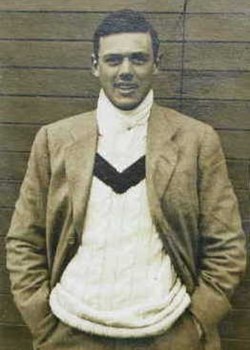22 August 1914: 2/Lt Vincent Waterfall
- Home
- On This Day
- 22 August 1914: 2/Lt Vincent Waterfall

One of the first aviators to be killed
Vincent Waterfall was born in Grimsby on 25 May 1891. He was commissioned in the 3rd Battalion, East Yorkshire Regiment, on 27 January 1912 after service as a Corporal in the Brighton College Contingent, Officers’ Training Corps. He trained as a pilot at the Vickers School in 1913 and gained RAeC Certificate No 461 on 22 April 1914. The pages of Flight for 1913 and 1914 trace his flying career, as he evolved from doing simple straight flights and circuits to more complex manoeuvres.
On 22 August he was undertaking a reconnaissance with Gordon Bayly.
Flying at 2,000 feet, their Avro 390 flew over the Enghien-Soignies area at around 10.50, making a pass at just 20 metres or so, the Germans so surprised that they failed to fire a single shot at an easy target flying low and slow. The plane banked and returned towards one of the columns; the reception was ready this time. The Avro crashed by the roadside.

At a time when untrained anti-aircraft fire was more beginners' luck than judgment, the gunners must have been dumbfounded. The excited infantry of the 12th Grenadiers were quick to claim the kill. Their Captain, novelist Walter Bloem, wrote:
Suddenly a plane flew over us... I ordered the two groups to fire at it... the plane started a half-turn... but it was too late: it went into a dive, spun around several times then fell like a stone about a mile from here.
Bayly and Waterfall had no choice but to go down with their ship. Parachutes were not worn: the Air Board saw them as un-British, likely to undermine the crew's fighting spirit and desire to stay with their machine, 'which might otherwise be capable of returning to base for repair'. They died on impact in a mess of splintered wood and propeller blades. Little wreckage was left after burning fuel incinerated the doped canvas and ash frame. Unsure what to do with their first dead foe - the fallen fliers they called 'Black Angels'- the soldiers doffed their caps, fired in salute over the smoking wreckage and hastily covered them with four inches of soil. Local Belgians placed flowers for those who had flown to rescue them from invasion. The local landowner later exhumed the corpses and placed them in zinc coffins, hidden in his distillery cellar to await a decent burial. For the German commander, Von Kluck, the wrecked Avro and bodies in RFC flying tunics gave the first proof that British Expeditionary Forces were on the continent of Europe.
To read more click here: Amongst the First To Fall - Early Casualties of the Royal Flying Corps in August 1914






